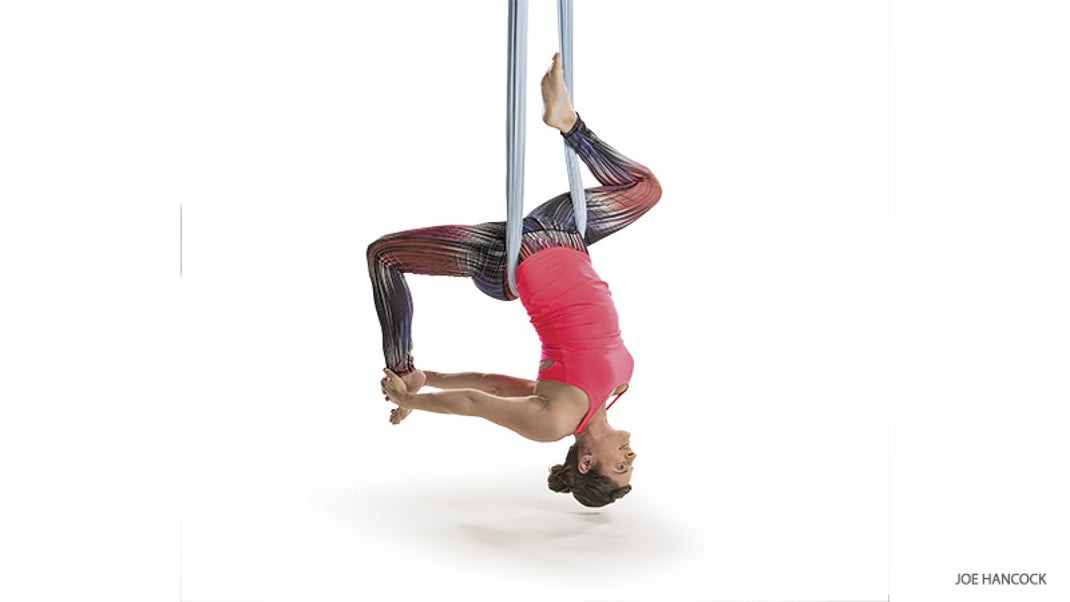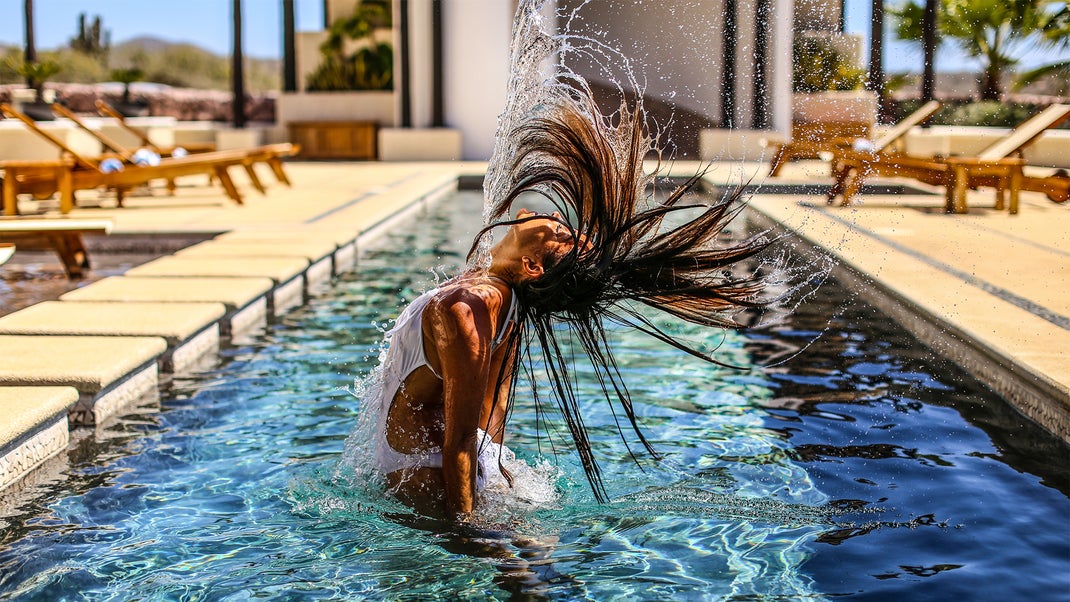In this 9-pose aerial yoga sequence, you will learn 9 poses that will defy gravity and help you get a full-body workout. Aerial Yoga is a wonderful way to improve your strength, balance, flexibility, and range of motion while also relieving stress from the mind. All you need for this pose is an open space where nothing can be overhead or below to block your fall.
One-Legged King Pigeon Pose is a great hip opener, but it is also an intense backbend, which for many of us creates obstacles for getting into this pose. If you have tight hip flexors, including the tight psoas, especially in the back leg, you will have to work harder to lift and extend your torso and chest into a backbend.
But using aerial silk or hammock allows gravity to help the back leg relax and the spine to curve naturally. You’ll stop fighting gravity, and allow the support of the hammock to help you lengthen. Give it a try!
Safety precaution: This sequence requires a deep inversion. If you find that holding Supta Konasana for a few breaths creates any discomfort or a feeling of pressure in the head, slowly return to standing and skip ahead to Eka Pada Rajakapotasana on your mat. Avoid this sequence if you have high blood pressure, heart disease, or glaucoma.
Aerial Lunges
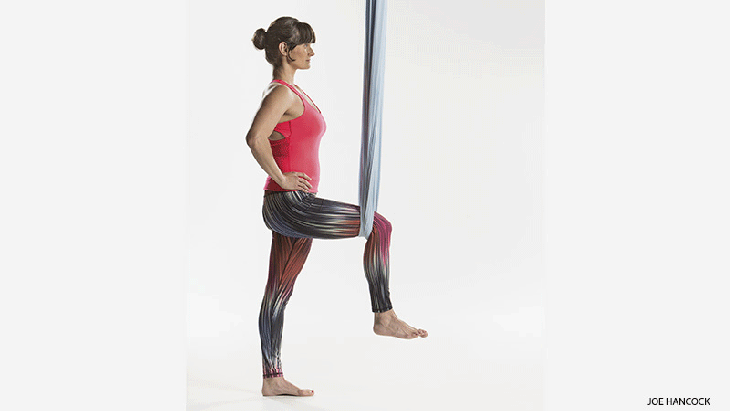 a. Stand in the center of your mat, directly behind your hammock. The bottom of the hammock should be at pubic-bone level. Stand close enough that your face is almost touching or does touch the hammock. With your hands, separate the right and left sides of the hammock, making a “U” shape. Place your right leg inside the U and bend your leg, allowing the hammock to support your upper leg, just above the knee. Make sure your left foot is still at the center of your mat, with the toes pointing forward.
a. Stand in the center of your mat, directly behind your hammock. The bottom of the hammock should be at pubic-bone level. Stand close enough that your face is almost touching or does touch the hammock. With your hands, separate the right and left sides of the hammock, making a “U” shape. Place your right leg inside the U and bend your leg, allowing the hammock to support your upper leg, just above the knee. Make sure your left foot is still at the center of your mat, with the toes pointing forward.
b. Place your hands on your hips. On an inhalation, lean forward into a lunge position with your right leg while keeping the left leg firmly rooted to the floor, stretching your left quad and hip flexors. On an exhalation, press the right leg strongly into the hammock, and move back to the starting position. Repeat 4 more times on the right side, then switch sides.
Without the hammock: High Lunge
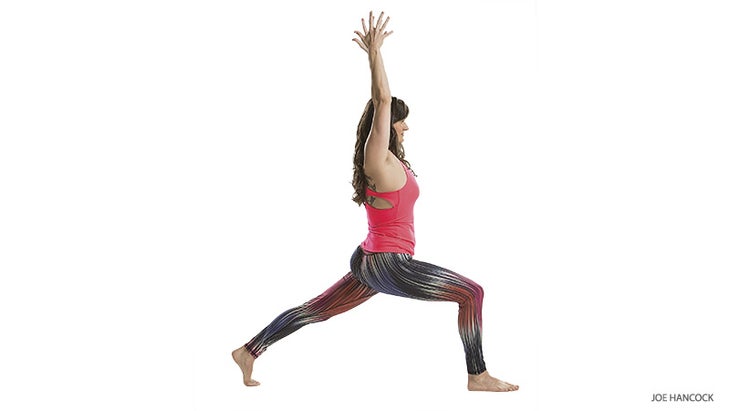
To build the same quad strength in your right leg and experience a similar stretch in your left quad and hip flexors on the floor, stand at the top of your mat and take a large step back with your left foot.
Keep the left toes tucked under and your right knee above your right ankle, in line with your hips. On an exhalation, lift the ball of your right foot off the floor so that your heel is the only part of the foot on the floor, and straighten your right knee. On an inhalation, place your entire right sole on the floor again, returning to a lunge. Repeat 4 more times, then change sides.
Half Boat Pose
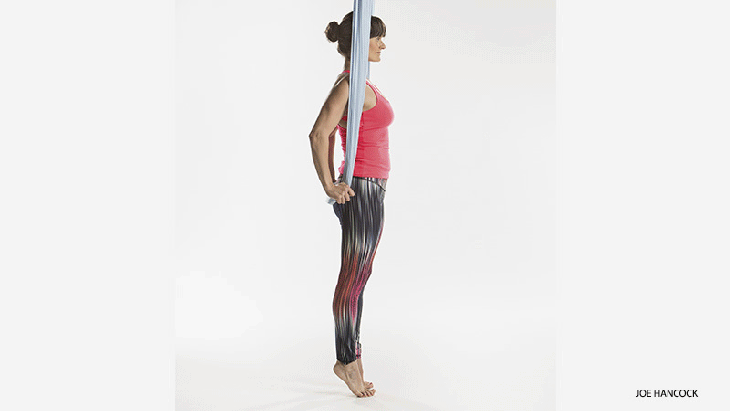
Ardha Navasana
a. Return both feet to the floor and stand in the center of your mat in front of the hammock; it should be so close that it is touching your glutes. Reach up and back to take hold of the two sides of the hammock, and slide your arms through as if it were two straps of a backpack. Then slide your hands down, pulling until the hands are at hip level and your inner wrists are resting against the hips. Stand on your tiptoes.
b. Step the feet as wide as the mat. Place your sacrum on the bottom of the U shape in the hammock. Lean back against the hammock and engage your abdominal muscles to lift the legs, while at the same time using strong arms to prevent the hammock from sliding up the back and swinging. Bend your knees to help transfer your weight from the floor to the hammock. Then slide your hands farther up the sides and straighten your knees, bringing your legs apart to help with balance. Adjust the fabric if it slips off the sacrum. Hold for 5 deep breaths.
Without the hammock: Half Boat Pose
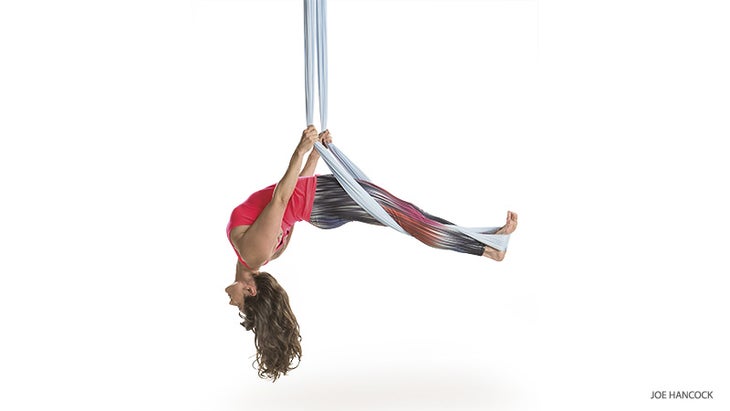
You can develop core awareness and strength on the floor as well, which will help you find control in the hammock, preventing you from swinging wildly as you move into Half Boat Pose in the air. From a seated position, bring your legs together and bend your knees. Hold underneath each thighbone, near the knee joint, and engage your abdomen. Lower your tailbone, then your sacrum, to the floor, starting to lie down on your back. Allow your feet to lift off the floor. Stop just before your lumbar region touches the floor, and hold the balance. Lengthen your legs; bring your arms to float parallel to each other and to the floor, palms up. Hold for 5 breaths, keeping the core engaged.
Reclining Angle Pose
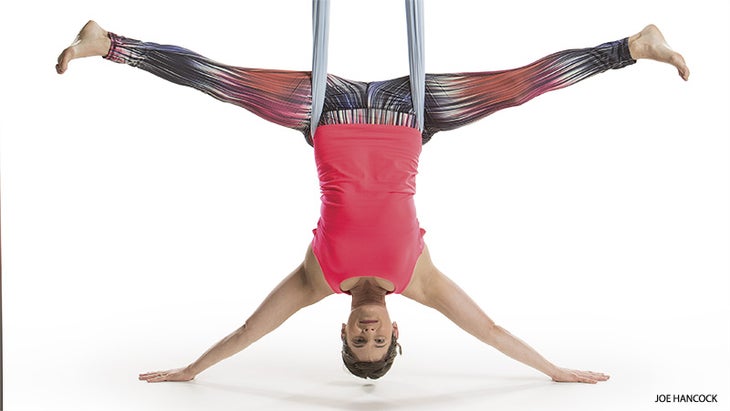
Supta Konasana
From Half Boat Pose, keep your legs as far apart as possible, and lean backward, letting your hands slide down toward the hips. If you feel stable once you’re upside down, you can release your hands to the floor, spreading the arms wide on the mat, palms facing down or toward the ceiling.
Let your legs be heavy, sinking toward the floor. Engage the lower abdominals to lengthen the lumbar spine, and move your tailbone toward your heels to help you balance. Take 5 slow, deep breaths.
Without the hammock: Bow Pose
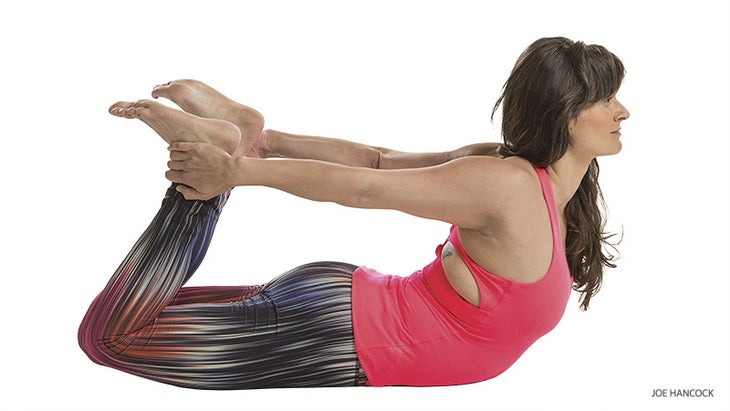 Dhanurasana
Dhanurasana
Bow Pose is an effective way to warm up the spine for the intense backbend in One-Legged King Pigeon Pose. Start by lying down on your belly. Bend your knees and reach back to take hold of the tops of your feet or your ankles. On an inhalation, kick the legs back, lifting the chest. Hold here for 5 breaths before exhaling to come out.
One-Legged King Pigeon Pose
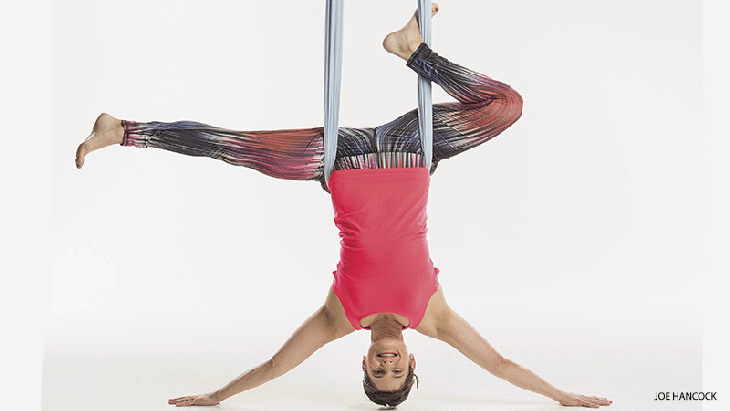 Eka Pada Rajakapotasana
Eka Pada Rajakapotasana
a. From Reclining Angle Pose, lift your head to look up at your legs. Bend the right knee to cross the shin over one side of the hammock. (If you need extra support, take hold of the sides of the hammock as you do this.) Lower your head (and arms, if you moved them) back toward the floor.
b. Keeping the right leg exactly as it is, rotate the left thighbone so that the back of the thigh is facing the floor. Allow your left knee to bend, and allow your foot to be heavy, so that your left foot drops toward the floor, finding yourself in an aerial version of King Pigeon. (For added security, you can also cross your right shin over both sides of the hammock.)
Bound One-Legged King Pigeon Pose
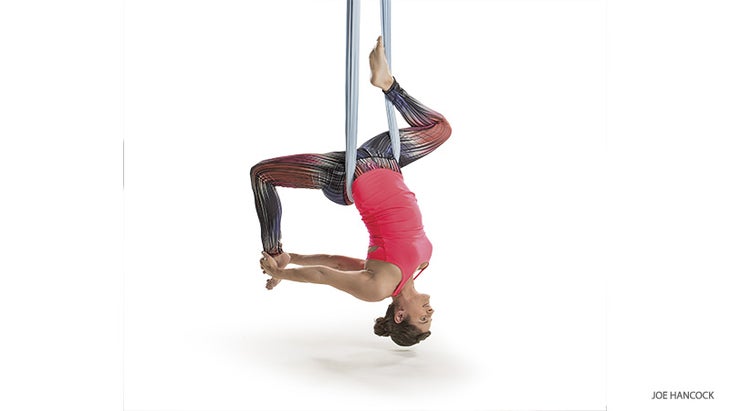
Baddha Eka Pada Rajakapotasana
c. From One-Legged King Pigeon Pose, reach back with either hand to grasp your left foot or ankle. If you have the flexibility, hold your ankle with both hands. Once you are in the bound pose, continue to allow the left thighbone to be heavy and sink toward the floor, opening up more deeply into the backbend.
Stay for 5 slow, deep breaths before releasing your left leg and returning to Reclining Angle Pose. Try the pose on the other side. To come out of the hammock, hold onto the sides with both hands and sit up. Unhook the hooked leg, and place both feet on the floor. Rest for a few breaths in Balasana (Child’s Pose).
Without the hammock: One-legged King Pigeon Pose to Bound One-legged King Pigeon Pose
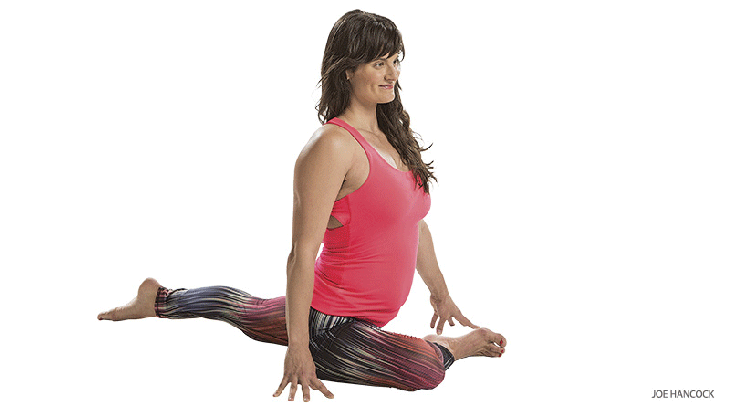 From Child’s Pose, lift up onto your hands and your knees, into Table Top. Slide your right knee forward between the hands, and slide your left knee back as far as it will go. Allow your right hip to sit on the floor or on a folded blanket in order to completely relax the left thigh and hip flexor muscles. Keep the right foot as close to the pubic bone as possible.
From Child’s Pose, lift up onto your hands and your knees, into Table Top. Slide your right knee forward between the hands, and slide your left knee back as far as it will go. Allow your right hip to sit on the floor or on a folded blanket in order to completely relax the left thigh and hip flexor muscles. Keep the right foot as close to the pubic bone as possible.
Conclusion:
Come up on fingertips to lift the chest. If you feel balanced, take hold of your left foot or ankle with your right hand. If you still feel steady, use both hands. Relax the left leg as much as possible, and use the hands to tug the foot toward the ceiling.
(You are using the arms to mimic the gravitational pull you felt on the foot when upside down.) You can look straight ahead or, ifit’s comfortable for the neck, gaze up at the ceiling. Hold for 5 breaths and repeat on the other side.

